What Is Normal? A Small College Town In Central Illinois
Normal is & isn’t many things, but it’s definitely a town in Illinois. The old downtown of Normal IL is undergoing a transformation and rebranding into Uptown Normal, which is the reason for this post. First, some background:
Normal is an incorporated town in McLean County, Illinois, United States. As of the 2010 census, the city population was 52,497. Normal is the smaller of two principal municipalities of the Bloomington-Normal metropolitan area, and the seventh-most populous community in Illinois, outside of the Chicago Metropolitan Area. The mayor of Normal is Chris Koos.
The town was laid out with the name North Bloomington on June 7, 1854 by Joseph Parkinson. From its founding it was generally recognized that Jesse W. Fell was the force behind the creation of the town. Fell had arranged for the new railroad, which would soon become the Gulf Mobile and Ohio, to pass west of Bloomington and then curve to cross the Illinois Central Railroad at a point where he owned or controlled land. Most of the Original Town lays south of the tracks, with Beaufort Street as its northern limit, and some blocks west of the Illinois Central and north of the tracks. Fell, his brothers, and associates quickly laid out many additions to the Original Town.
The town was renamed as Normal in February 1865 and officially incorporated in 1867. The name was taken from Illinois State Normal University, a normal school (teacher-training institution) located there. The school has since been renamed Illinois State University after becoming a general four year university. Normal is adjacent to Bloomington, Illinois, and when mentioned together they are known as the “Twin Cities”, “Bloomington-Normal”, “B-N”, or “Blo-No.” (Wikipedia)
Bloomington’s 2010 population was 76,610 for a combined total of 129,107 with a 40/60 split between the two municipalities. Why Normal?
Last month I attended a LEED-ND workshop sponsored by the USGBC Missouri Gateway Chapter.
The LEED for Neighborhood Development Rating System integrates the principles of smart growth, urbanism and green building into the first national system for neighborhood design. LEED for Neighborhood Development is a collaboration among USGBC, Congress for the New Urbanism, and the Natural Resources Defense Council. (Source)
The facilitator was architect/planner Doug Farr. Of the numerous examples presented one was in Normal IL, with a traffic circle with the center as a destination spot. The circle includes water features using filtered storm water. I was intrigued. A few hours later I had my train ticket and hotel reservations for the Friday and Saturday night before Memorial Day.
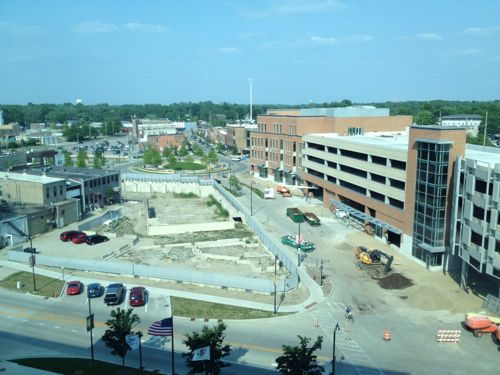
Many of the old buildings were razed, new parking garages built, and street patterns were changed. From Farr & Associate’s website:
Despite being home to Illinois State University and having a population of 22,000, downtown Normal has been in a prolonged state of decline, marked by reduced retail choices and deferred building maintenance. Farr Associates prepared a redevelopment master plan to revitalize the downtown. The preliminary $211 million redevelopment plan is anchored by a new traffic circle and stormwater-treating fountain, an Amtrak multi-modal high speed rail facility, a new children’s museum, beautiful streetscaping, and new retail and mixed-use buildings. (Source)
The railroad line runs behind the buildings on the right in the picture above. Currently passenger service is on the far side of the tracks, away from the new development in Uptown.
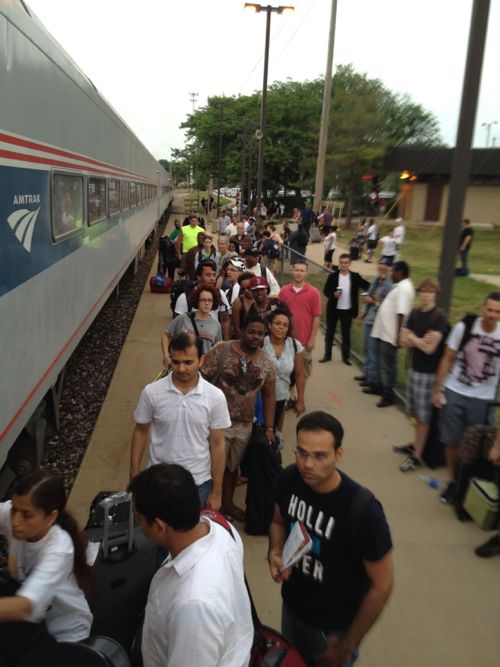
With Illinois State University within walking distance students use Amtrak often. Students returning in the fall will get off the train near the Uptown Circle.
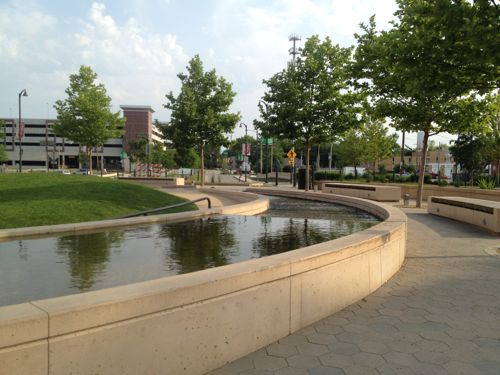
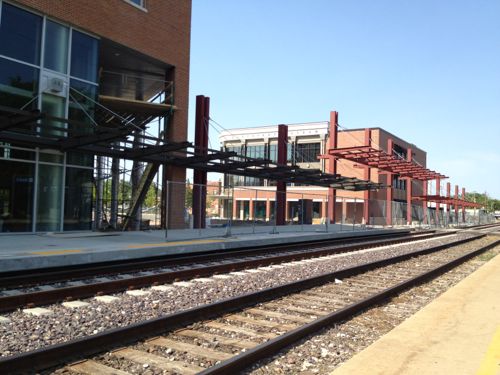
The new station will be in the building on the left. Also in the building and garage will be the Bloomington-Normal Public Transit System, the bus service operated independently of the two municipalities. The top two floors will become the new Normal City Hall. The existing city hall near the existing Amtrak station will be full with other departments, including more room for the police department.
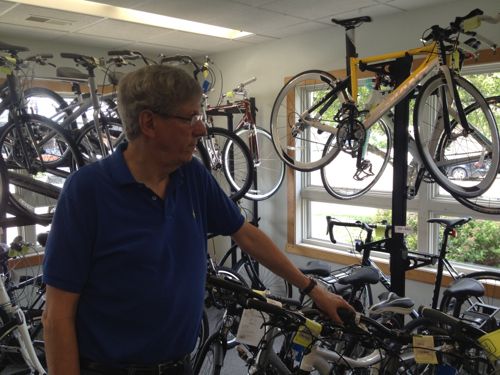
I met with Mayor Chris Koos at his bike shop to discuss the goals and process of this dramatic change. Koos has been mayor since 2003, their elections are non-partisan. I asked if people questioned all the bike racks in Uptown since he sells bikes for a living. “All the time” he said, adding “My response to then is ‘Would you question the street resurfacing budget if I owned a car dealership?'” I was quite surprised by the number of pedestrians and cyclists I saw — more bikes than I’d see in all of downtown St. Louis!
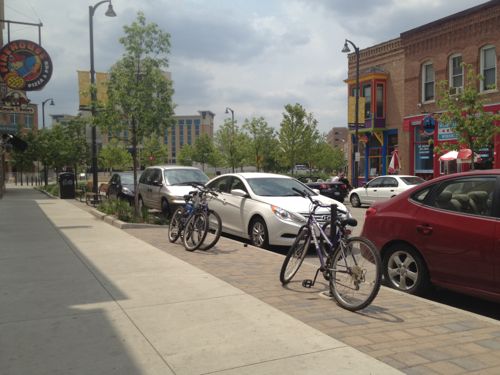
One area has so much demand for bike parking that an automobile space on the street has been converted to bike parking.
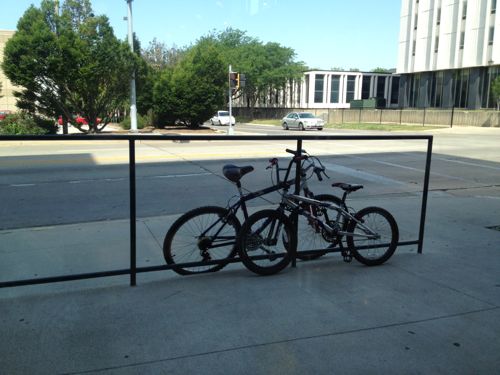
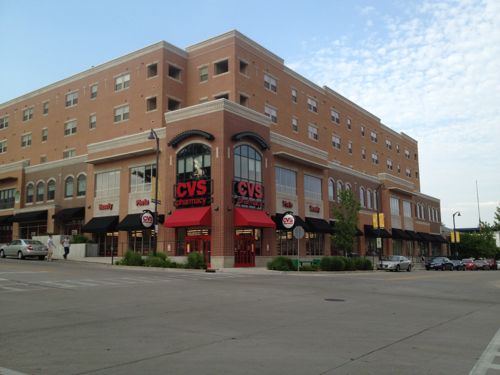
Really? Normal can get an urban CVS while we get typical suburban stand alone stores in a sea of parking? Other retail spaces in the building aren’t yet leased, the apartments above are off campus housing managed by ISU. Nice to see a university involved in new high-density urban development! Someone get Biondi a train ticket to Normal IL.
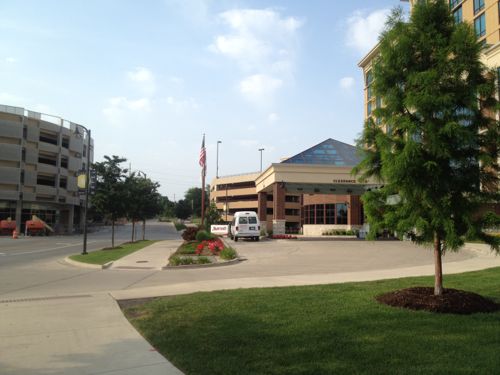
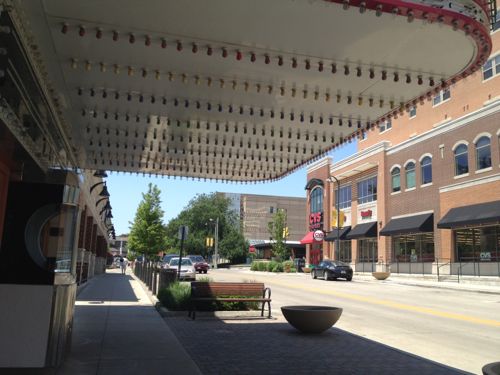
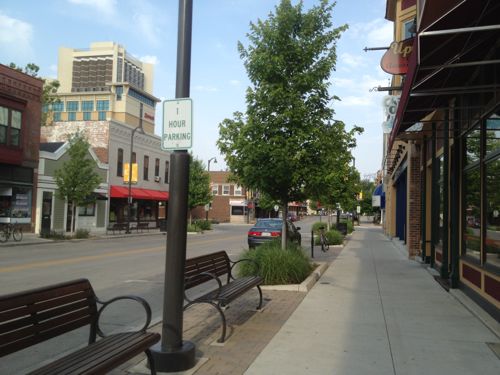
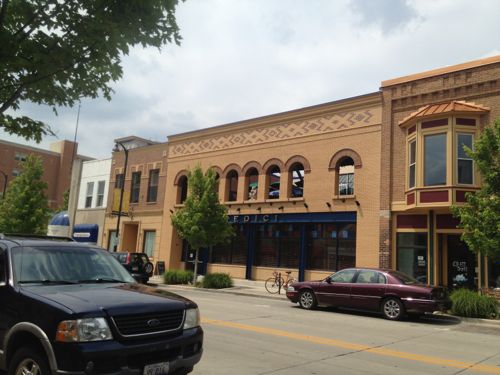
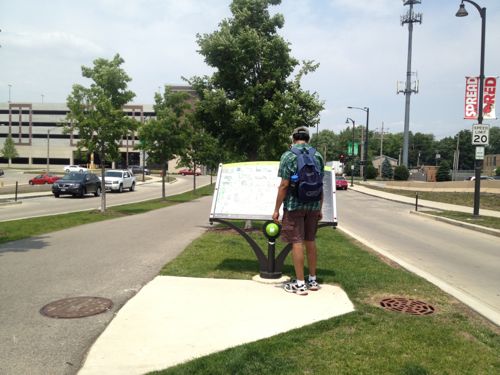
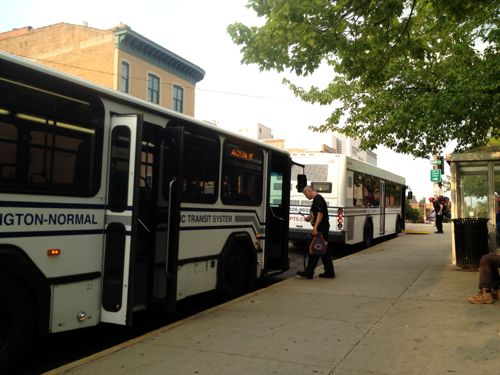
I’ll return for another visit once the new Amtrak station is open and more new buildings have been finished. It would be nice to visit during the school year to see how active Uptown is or isn’t. On the train trip I noticed evidence of track work to reduce delays.
– Steve Patterson
Sounds like a lot of college towns, much like Boulder, where I went to CU. The real challenge is moving from the academic ivory tower to more, pardon the pun, normal towns, places like Springfield, O’Fallon, orMt. Vernon, where the demographics don’t skew toward young, single and highly-educated.
One 20-something I talked to that attends a different college in B-N says everyone goes to Bloomington because there’s more to do, more bars.
Are you trying to make a distinction between two sister cities? I tend to view city pairs as a single entity – B-N, Champaign-Urbana, Minneapolis-St. Paul – if the residents treat them as one. Yes, they’re politically distinct, but to most residents it’s more like cities in St. Louis county – we don’t know who the mayor is, but the name defines a neighborhood.
Edwardsville-Glen Carbon…
They have two sets of governments, one is the county seat. Transportation is handled by a third and K-12 schools a 4th. The lesson here is Normal had to dig up part of its downtown for a new storm water system but rather than just put back what they had they used that as an opportunity to reevaluate and explore other options. The idea of evaluation and exploration can and should be applied to every small town.
Why limit it to just small towns? Why can’t we do the same thing in STL?
It’s not limited.
I just finished up my coursework at Illinois State. I saw the whole transformation of Uptown Normal: the roundabout is a gathering place during the warm parts of the year. Families and college students alike use it: it is a fantastic community and there is a lot to do in the Uptown area, but you’re right about downtown Bloomington: the college bar scene is down there and over the weekends the party-but business heats up to take students downtown.
Normal is a great place to go without a car as well: I didn’t have a car there until my last few months of college, and did all of my grocery shopping and errand-running on the bus. Yes, the excursions are longer by bus than by car, but it was not any major inconvenience. Be warned, though: if you go back, certain busses are JAM-PACKED with students through the school year. (The Pink-D is the worst!)
This was an enjoyable post! Thanks!
I would think an architectural competition would have came up with a better solution. The traffic circle, while it has some value is essentially cut off from everything else by numerous traffic lanes. Looking at the plan view there are also routes directly connected to what is supposed to be a public space (the traffic circle) full of parking spaces rather than the commercial/residential development needed to feed the public space (with parking behind) . I like the train connection, the general idea has merit, but to me it looks to fail on the details.
I would guess this traffic circle will end up like St. Louis University with its various “open public spaces” unused and visible only to people speeding by in cars.
The reality is the traffic circle is dead space. Go to the center drive through Tower Grove Park and even in that much smaller in scale traffic circle you seldom see anyone in the circle itself, even when the p;ark is crowded.
While I appreciate the effort, it appears to fall well short of what is really needed to revitalize this community.
The inability to create useful and important public space, and especially how to feed that space with surrounding architectural/city design is in my view is the biggest failure of the current architecture and city planning disciplines and concurrent policies that result. This is a prime example.
I know that the circle looks like dead space in some of these photos, but perhaps that’s just because it is summer. This whole area caters to the “college-town” crowd. I’ve been in the circle working on homework on Sunday afternoon, and it was quite crowded in the circle. Maybe it is because there isn’t public space around the circle, so if you want to stop somewhere, that’s the only place to do it. The circle doesn’t have heavy traffic, so it is not hard to get across at all.
As for the lack of residential area, you are correct! This community is very suburban in it’s development: a quick drive (or bus ride) out to Veterans Parkway will reveal strip mall after strip mall, behind which are large suburban houses. The older, walkable parts of down have fallen into decline. (Hence the revitalization of uptown!)
I think uptown will remain a strong business district because there are 20k students, two blocks away, many of whom have no cars. Walking to the restaurants and shops there is often the most convenient way to grab a bite to eat or run a few errands. Google “Watterson Towers” to get an idea of the number of students: it is caddy-corner from that CVS.